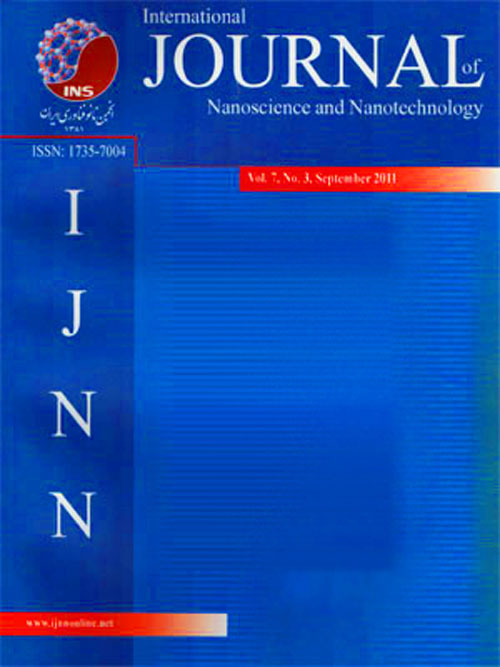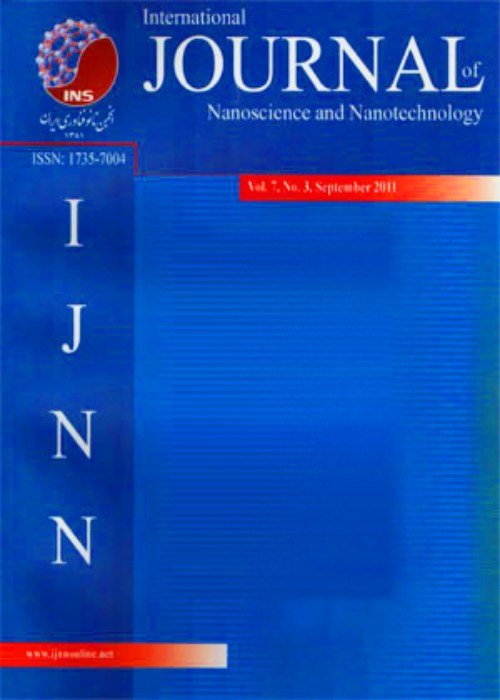فهرست مطالب

International Journal Of Nanoscience and Nanotechnology
Volume:16 Issue: 2, Spring 2020
- تاریخ انتشار: 1399/03/19
- تعداد عناوین: 6
-
-
Pages 73-89
The study aimed at the synthesis and antibacterial activity of ZnO nanoparticles (NPs) from organic extracts of Cola nitida and Cola acuminata leaf using zinc chloride (ZnCl2) and zinc acetate dihydrate [Zn(CH3COO)2∙2H2O] as precursors on selected Gram positive and Gram negative microbes: Staphylococcus aureus, Exiguobacterium aquaticum, (Gram +ve) and Escherichia coli, Klebsielia pneumonia, Acinetobacter baumanni (Gram –ve). Spherical and flake-like nanostructures were recorded by Scanning Electron Microscopy (SEM) for C. acuminata and C. nitida respectively for the two precursors used. The average particle size and crystallite size determined by Transmission Electron Microscopy (TEM) and X-ray Diffraction (XRD) for C. acuminata and C. nitida were in the range of 32.15-43.26 nm; 69.12-84.26 nm and 14.69-17.12 nm; 23.68-23.96 nm respectively. Energy-dispersive X-ray spectroscopy (EDX), UV- visible spectroscopy (UV-vis), Atomic Absorption Spectroscopy (AAS) and Fourier-transform infrared spectroscopy (FT-IR) techniques were used to observe the purity and surface functional groups of the samples. Spectra peaks at 440-458 cm-1 and 364-370 nm confirmed the presence of ZnO in the samples by FT-IR and UV-vis, whereas AAS at 213.9 nm wavelength further confirmed elemental zinc with a percentage atomic weight of 71.37% as against 69.50%, 18.8% and 11.1% for Zinc, Oxygen and Carbon by EDX. Data from the antibacterial activity studies show an increase in inhibition rate as concentration of the ZnO NPs increases in concentration from 25-1000 ppm. ZnO NPs from the two extracts recorded the highest inhibition rate in Acinetobacter baumanni of approximately 88% and 49% using ZnCl2 and Zn(CH3COO)2∙2H2O respectively.
Keywords: Precursor, Functional groups, microscopy, nanostructure, Spectroscopy -
Pages 91-102Electrochemical performance of binary and ternary oxides composed of Ni, Co and Cu produced over a 3-dimensional substrate of vertically aligned carbon nano-tubes (VACNT) as electrodes for aqueous energy sources, is reported and compared in this paper. VACNTs were fabricated inside a DC-plasma enhanced chemical vapor deposition chamber and composite materials fabricated by thermal decomposition method on the surface of VACNT electrodes. XRD, Raman and electron microscopy tests were used to verify electrodes proper composition and interface between the electrodes substrate and active material. Cyclo-voltammetry experiments were done over electrodes and Co-Cu oxide/VACNT electrode found to have the highest charge capacity of 230 mC cm-2 among the electrodes. Electrical impedance spectroscopy was done to determine electrodes electrical behavior in different frequencies and find their characteristics quality as well.Keywords: Carbon nanotubes, Composite materials, Energy Storages, Electrical properties.
-
Pages 103-115
An investigation is carried out on MHD stagnation point flow of water-based nanofluids in which the heat and mass transfer includes the effects of slip and convective boundary conditions. Employing the similarity variables, the governing partial differential equations including continuity, momentum, energy, and concentration have been reduced to ordinary ones and solved by using Keller-Box method. The behavior of emerging parameters is presented graphically and discussed for velocity, temperature, and nanoparticles fraction. The numerical results indicate that for the stretching sheet, the velocity at a point decreases with the increase in the values of and M; whereas both temperature and nanoparticle concentration increase with the increase in velocity slip parameter ( , magnetic parameter (M) and convective parameter ( . And also, observed that the velocity profile increases with the increase in velocity ratio parameter.
Keywords: MHD, Stretching Sheet, nanofluid, Velocity Slip, Convective boundary condition. -
Pages 117-125Amido-amino functionalized halloysite stabilized copper nanoparticles (aah-CuNPs) were synthesized through one-pot protocol by a wet chemical method using hydrazine as reducing agent. The nanocomposite formed was stable in dry ethanol. The composition and binding nature of the nanocomposite were studied using FT-IR, DRS-UV, EDAX and powder XRD techniques. The morphological features of the composite were obtained from HRSEM analysis. The thermal stability of the copper nanocomposites was studied using TGA analysis. The prepared nanocomposite displayed broad spectrum antimicrobial activity, and it was very effective in Ullmann aromatic amination reaction.Keywords: Amido-amino clay, Aromatic amination, Catalysis, Copper nanoparticles, Ullmann reaction.
-
Pages 127-136Carbon nanotubes (CNTs) have very promising applications for inhibition of microbial growth. The aim of this study is investigation and comparison of the effect of temperature and acidity on antimicrobial activities of pristine Multiwalled Carbon nanotubes (MWCNTs) and Multiwalled Carbon nanotubes-Arginine (MWCNTs-Arg). Minimum Inhibitory Concentration (MIC) and Minimum Bactericidal Concentration (MBC) were calculated in range of temperature (25, 37 and 42 ºC) and pH (4.2, 7.2, and 10) on Staphylococcus aureus. The results approved that pristine and functionalized MWCNTs have broad-spectrum antimicrobial activities against examined pathogen. Between these agents, MWCNTs-Arg and pristine MWCNTs and have the highest inhibitory activity on microbial growth, respectively. The MBC value of MWCNTs was improved by amino acid functionalization. The optimal pH for antimicrobial activity of pristine MWCNTs and MWCNTs-Arg are 4.2 and 7.2 and optimal temperatures are 42 ºC and 42 ºC, respectively. There is no change on optimal temperature of MWCNTs by this functionalization, but functionalization of MWCNTs by Arg enhanced its antimicrobial activity and led to change of optimal pH of MWCNTs for antimicrobial activity. This changes lead to suitable improvement of antimicrobial activity in neutral and biological pH.Keywords: Antimicrobial, Arginine, MWCNTs, pH, Temperature.
-
Pages 137-144In this research, Ni-Mo/Cs1.5H1.5PW12O40/S (S=SiO2 or Al2O3 or ASA (amorphous silica alumina)) nanocatalysts with different supports were prepared via 2 steps with impregnation method and the effect of support on the characteristic and catalytic properties of the prepared samples was studied. The synthesized samples were characterized by X-ray diffraction (XRD), temperature programmed desorption (TPD), temperature programmed reduction (TPR), and energy dispersive X-ray spectroscopy (EDX). Morphology of the samples was studied by field emission scanning electron microscope (FE-SEM) and the surface area, pore volume and pore size of the catalysts were determined by BET (Brunauer-Emmett-Teller) method. In the XRD patterns of the prepared catalysts, the H3PW12O40 (HPW) phase was observed. The FE-SEM images showed that the synthesized particles were in nanoscale. The results of TPD studies indicated that moderate acidic sites of Al2O3 supported nanocatalyst was more than the others. The catalytic activity of the nanocatalysts in hydrocracking of n-decane indicated that Al2O3 supported nanocatalyst had the highest catalytic activity.Keywords: Heteropoly acid, nanocatalyst, Hydrocracking, Al2O3.


